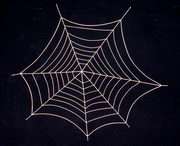Scientist Will Examine Spider Silk Use for Sutures

A University of Wyoming molecular biologist will use the renewal of a half million dollar Air Force grant to develop spider silk for military and medical applications.
College of Agriculture Professor Randy Lewis said the research will examine using spider silk as sutures. There is also interest in using spider silk technology as scaffolding for regenerating ligaments or tendons in humans.
The grant will continue research by his team into production of spider silk for various commercial purposes. But first, spider silk has to be produced in sufficient quantities. For that, the specific spider silk gene has been placed into the goat genome and the protein then extracted from milk and spun into fibers. Canada-based Nexia Biotechnologies Inc. in Montreal, Quebec, has been using the process in transgenic goats.
The University of Wyoming will begin processing the goat's milk containing the spider silk protein for the production of recombinant spider silk - BioSteel - for Nexia. About 5,200 pounds, or about 600 gallons, has been delivered, says Lewis, who has built an international reputation for his spider silk research.
The purified BioSteel is provided to companies and institutions that have an interest in developing Nexia's technologies, according to the company. Nexia recently renewed its exclusive spider silk gene licensing agreement with UW for all commercial fields relevant to Nexia.
Lewis also recently received a $200,000 Department of Army grant to provide equipment to further purify spider silk proteins. The grant will develop fibers for use in bulletproof wear. About 600 gallons of goat milk is needed to produce a 5-pound bulletproof vest. Because of the volume needed, Lewis and his team have conducted research introducing the spider silk protein in alfalfa, but quantities produced are not yet at commercially useful levels.
A possible $1.5 million National Institutes of Health grant would examine placing spider silk in a body for use as a scaffolding matrix for growth of a new ligament as opposed to growing a ligament in a biobath using silkworm silk. A researcher discovered that cells used to rejuvenate ligaments act differently when stretched and relaxed.
Silk worm silk is not flexible, Lewis says. No such problem with spider silk.
"The implication is that we could do this in the body and not have to do it outside," says Lewis. "If they use silkworm silk, they have to make the ligament work to the point it can be implanted as the silk is too weak and has no elasticity to function as the ligament replacement. With our silk, we would just start the process and then implant the ligament. The natural motion of the silk ligament would provide the stimulus for the cells to fill in and generate the new 'natural' ligament."
The spider silk research has drawn scientists to UW. Lewis says more than three post-doctoral students have come to UW from larger institutions to conduct research, and five graduate students have contacted him prior to applying to graduate school to ensure there would be positions. He has seven undergraduates working fulltime this summer.
Source: University of Wyoming

















